LANDSCAPE MATERIALS
How do you determine the square footage of a project?
- Rectangles and squares: Area = Length x Width ex. The length = 25 ft. and the width = 8 ft. Area is:25 x 8 = 200 sq ft.
- Triangle: Area = Base xHeight / (divide by) 2 ex. The base = 30 ft. and the height = 20 ft. Area is (30 x 20) / 2 =300 sq ft.
- Circle: Area = 3.14 x Radius2 ex. The radius(half the diameter of a circle) is 9 ft. Area is 3.14 x (9 x 9) = 254 sq. ft.
How do you determine the quantity of bulk material you will need for a project.
- Figure out the square footage of the area.(see example above)
- Determine desired depth of material (see depths chart below)
- Square feet divided by square feet per yard (see conversion chart below) = cubic yards needed
|
CONVERSION CHART Converts square feet to cubic yards 1 cubic yard will cover the following amount of square feet at the given depth |
DEPTH CHART This is our recommended depth when installing the following materials |
||
|
¼” deep |
1296 square feet |
Bark Mulch |
3” deep |
|
½” deep |
648 square feet |
Stone < 1” diameter |
3” deep |
|
1” deep |
324 square feet |
Stone 1 – 2” diameter |
3-4” deep |
|
2” deep |
162 square feet |
Soil for Lush Lawns |
4+” deep |
|
3” deep |
100 square feet |
Garden Soil in Flower Beds |
6-12” deep |
|
4” deep |
81 square feet |
Lawn Topdressing |
1” deep |
|
6” deep |
54 square feet |
Pathways |
4” deep |
|
12” deep |
27 square feet |
Topdressing Already Mulched Beds |
1” deep |
|
Got Questions? Call Lang Landscape Today at (920) 731-0852
|
|||
How much does stone/soil/mulch weight?
- Soil weights about 2,000 – 2,200 lbs per cubic yard
- Stone weights about 2,500 – 2,700 lbs per cubic yard
- Mulch weights 200 – 500 lbs per cubic yard
How many yards of material can a pickup truck hold and is there someone there to load my vehicle?
During our regular business hours there will be someone available to load mulch/stone or soil.
- Full size truck (with regular box)* ~ Mulch 3 yard (heaping load) ~ Soil/Stone 1/2 – 1 yard
- Small size truck* ~ Mulch 1 1/2 yards (heaping load) ~ Soil/Stone 1/3 – 1/2 yard
- *(See owner’s manual of your truck for weight capacity)
Does Lang Landscape deliver or install mulch or stone?
Lang Landscape is a full service landscape company. We offer delivery and installation services on mulch, stone, soil and many more products.
What is a cubic yard equivalent to?
- 27 cubic feet in 1 cubic yard
- 21 bushels in 1 cubic yard
- 7 to 12 wheelbarrow loads in 1 cubic yard
- 54 soil/stone bags in 1 cubic yard
- 27 bark/mulch bags per cubic yard
PLANT CARE
How often do I water and fertilize my new plant(s)?
CLICK HERE for: Plant Care brochure PDF for all the details on caring for your new plant.
What kind of warranty do you have on your plant material?
- Perennials/Grasses – They are warranted until to the end of the season.
- Seedling/Transplants – They are warranted one year from date of purchase.
- Roses – They are warranted until to the end of the season.
- Shrubs – They are warranted one year from date of purchase.
- Evergreens – They are warranted one year from date of purchase.
- Trees – They are warranted one year from date of purchase.
We will extend our warranty on shrubs, evergreens and trees to TWO years if you purchase root stimulator at the same time as your shrubs, evergreens or trees.
What is root stimulator?
Instead of encouraging top growth like most fertilizers, root stimulator specifically targets root growth, formation and development. Stress is a major concern when transplanting or repotting. Using a plant starter or root stimulator will reduce transplant shock and help your plants flourish and promotes greener more vigorous plants.
When is the best time to plant?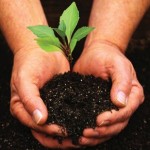
Container grown plants can be planted at any time of the growing season. The best time to plant them is when you have time to properly maintain and care for the new plants.
When can I transplant evergreens, perennials, trees and shrubs?
- Perennials – The best time to transplant/divide is Spring.
- Shrubs – The best time to transplant is Spring.
- Evergreens – The best time to transplant is Spring.
- Bare root – The best time to transplant is Spring.
- Trees – The best time to transplant is Spring.
When should I start spraying my fruit trees and what if I missed my 1st application?
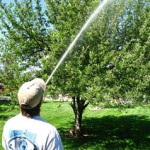 Fruit trees as well as flowering crabapples should first be sprayed when the leaf buds are showing green tips, and outdoor conditions are favorable. As with any chemical, be sure to read the label for proper application rates or consider hiring a professional. If the first application of spray is missed, it is not too late to spray for the season; just be aware that any insect or fungal damage that occurred to the leaves before spraying may remain on the plant for the growing season.
Fruit trees as well as flowering crabapples should first be sprayed when the leaf buds are showing green tips, and outdoor conditions are favorable. As with any chemical, be sure to read the label for proper application rates or consider hiring a professional. If the first application of spray is missed, it is not too late to spray for the season; just be aware that any insect or fungal damage that occurred to the leaves before spraying may remain on the plant for the growing season.
How long do I keep my tree staked?
Your tree should be staked for one year and removed when ground is dry. If your tree is planted in April 2009 you should remove the stakes in July of 2010 when the ground is dried up.
What is bare root plants and why are they cheaper?
A bare root plant is a plant that is sold with the roots exposed, rather than in soil. Plants that are received bare root are dormant and should be planted ASAP. Until planted roots should be kept moist at all times. Bare root plants are cheaper because shipping plants without soil is much cheaper, so we can extend the savings to our customers.
LAWN CARE
How do I care for my new or existing lawn and do you offer a yearly fertilizer program?
Lang Landscape offers a 4 step fertilizer program for new and existing lawns. We also have a Lawn Care brochure that explains basic lawn instruction on caring for your lawn – Click here for PDF.
What is the best height to mow your grass to?
It is recommended that you do not mow your lawn any lower than 3″.
How much water should my lawn get per week?
Your lawn should get on average about 1″ of water/rain per week.
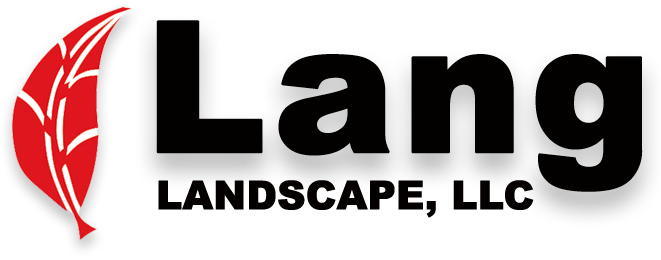



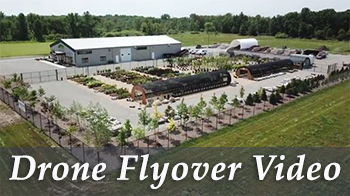
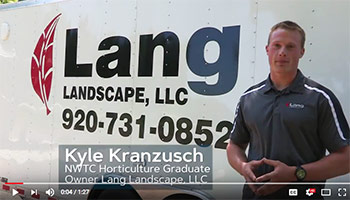
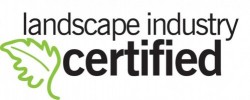



Follow Us!